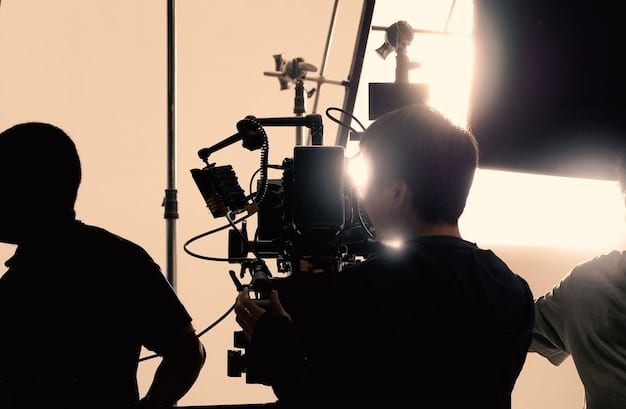Cable original production budgets: Where does the money go?

Original cable productions face immense financial pressures, with cable original production budgets allocated across talent, production, marketing, and often requiring intricate balancing acts to deliver engaging content to audiences while battling rising costs and intense competition.
Ever wondered where all the money goes when your favorite cable show gets made? The world of cable original production budgets is not just about glamorous sets and star-studded casts; it’s a complex financial ecosystem.
From the initial script to the final cut, every cent is meticulously planned, debated, and often stretched to its limit to bring compelling stories to life on screen.
Understanding these intricate budget allocations provides a fascinating glimpse into the realities and challenges faced by cable networks today.
The anatomy of a production budget: Initial allocations
The journey of a cable original production begins long before cameras start rolling, deeply embedded in the intricacies of cable original production budgets.
These initial financial blueprints are crucial, setting the stage for everything from creative choices to marketing strategies. A typical major cable production can see its budget soar into the tens of millions of dollars per season, or even per episode for high-concept shows.
The initial phase involves breaking down these colossal figures into actionable categories, ensuring that every department receives the necessary funding to achieve its objectives. This meticulous planning is the backbone of any successful series.
One of the first and most significant chunks of a production budget is often earmarked for development. Networks invest heavily at this stage, viewing it as a critical filter to ensure that only the most promising concepts advance to active production.
Without strong material and visionary leadership, even the most generously funded production can falter.
Development and pre-production costs
Pre-production is a phase of intense planning and preparation, and cable original production budgets must cover location scouting, casting, costume design, set construction, and specialized equipment rentals.
Oversights here can lead to costly delays and reworks. Experienced line producers and unit managers meticulously manage these funds, ensuring efficiency.
Insurance and legal fees also accumulate, adding to the significant financial outlay before a single frame is shot.
The price of star power and crew: Talent and labor
The human element is one of the most expensive parts of cable original production budgets. A-list actors, acclaimed directors, and skilled crew demand high salaries, often with complex contracts including residuals and backend deals.
Beyond marquee names, unions dictate pay scales and benefits, making payroll a substantial drain on resources. For many shows, the cumulative cost of human capital is the single largest expenditure.
Crew salaries and union costs
Unionization further increases labor costs. Agreements with SAG-AFTRA, DGA, and WGA ensure fair compensation but add complexity.
The scale of production directly affects crew size and duration, creating a delicate balance between creative ambition and fiscal discipline.
Cable original production budgets must therefore account for overtime, benefits, insurance, and employment taxes, making efficient scheduling critical.

Visual spectacle: Production design, VFX, and music
High-concept storytelling demands significant portions of cable original production budgets for sets, props, VFX, and music.
Elaborate construction, immersive world-building, and cutting-edge CGI elevate production value but come with steep costs. Music licensing and original scoring also add millions, yet they often define a show’s identity and justify the expense.
The expensive art of special effects
Modern productions rely heavily on VFX, with some sequences costing hundreds of thousands per minute. Skilled artists, advanced software, and rendering farms drive up expenses, but they are essential for creating cinematic-quality television that attracts loyal audiences.
Location, logistics, and living expenses: On-location shoots
Authentic backdrops add richness but complicate cable original production budgets. Permits, travel, accommodations, and per diems quickly inflate expenses.
Moving hundreds of people and equipment across states or countries demands detailed planning and contingency funds. Every extra day on location compounds costs, making efficiency and foresight paramount.
Travel, accommodation, and per diems
Flights, hotels, stipends, and transport vehicles form massive budget line items. Beyond direct costs, productions must provide catering, storage, and temporary infrastructure.
Weather delays or technical issues often lead to overruns, reinforcing the need for flexible and well-protected budgets.
Post-production pains: Editing, sound, and marketing
Post-production transforms raw footage into polished content, consuming a large share of cable original production budgets. Editing, sound mixing, VFX refinement, and color grading require expensive equipment and top-tier professionals.
Marketing then takes center stage, with multi-million-dollar campaigns across TV, digital, and social platforms, ensuring visibility in a saturated market.
Marketing and distribution
Advertising, press events, and promotional campaigns drive awareness, but they also represent one of the most variable components of cable original production budgets.
Even distribution and digital archiving add costs, reinforcing the financial stretch productions face after filming ends.
Contingency planning and overruns: The unexpected costs
Even the most carefully designed cable original production budgets face overruns. Weather delays, technical breakdowns, illnesses, or creative changes all strain resources.
To mitigate risks, contingency funds of 10–15% are set aside. These reserves allow productions to survive disruptions without compromising quality or abandoning projects.
Mitigating financial risks
Insurance, buffer schedules, and proactive planning reduce the impact of setbacks. However, reshoots, licensing disputes, or expanded VFX still push costs higher.
A flexible yet disciplined approach ensures that even with challenges, productions remain financially viable.
Return on investment: Measuring success and future strategies
The ultimate test of cable original production budgets lies in return on investment. Networks measure not just ratings but also awards, subscriber retention, global licensing, and brand prestige.
Each expenditure aims to transform financial risk into creative and commercial payoff.
The role of data analytics in greenlighting
Data-driven insights now guide the allocation of cable original production budgets. By predicting audience preferences and potential viewership, networks reduce risks and maximize profitability.
Analytics inform decisions on casting, marketing, and even genres, ensuring money is spent strategically.
Looking ahead, cable networks refine cable original production budgets through co-productions, tax incentives, and innovative technologies.
The cycle of investment, production, and measurement ensures that cable originals continue captivating audiences while striving for sustainable business models in an increasingly competitive industry.
| Key Area | Brief Description |
|---|---|
| ✍️ Development & Pre-production | Securing IP, scriptwriting, casting, set design, and initial logistics قبل filming. |
| 🎬 Talent & Crew Wages | Salaries for actors, directors, writers, and the large technical crew, including union benefits. |
| ✨ Production Design & VFX | Costs for elaborate sets, props, visual effects (CGI), and original music scores. |
| 🗺️ On-Location Logistics | Permits, travel, accommodation, and daily expenses for filming outside of studios. |
Frequently Asked Questions (FAQ) about Cable Production Budgets
The largest expense in a cable original production budget is almost always talent and crew wages. This includes the salaries of lead actors, supporting cast, directors, writers, and the extensive technical crew. Union agreements and the high demand for skilled professionals drive these costs substantially, often consuming well over half of the total budget for a series.
Visual effects can drastically impact a show’s budget, especially for genres like sci-fi, fantasy, or historical dramas. Complex CGI, digital environments, and creature effects require specialized artists, powerful software, and significant rendering time, leading to costs that can easily run into millions per episode. The more intricate the VFX, the higher the expenditure.
Marketing is crucial because even the best show needs to be seen. In today’s saturated entertainment market, networks must invest heavily in advertising across TV, digital, and social media to generate buzz, attract viewers, and differentiate their content. Effective marketing is essential for audience acquisition and ensuring the show’s financial viability and viewership success.
A contingency fund is a percentage (typically 10-15%) of the total production budget set aside for unforeseen expenses or issues. It’s vital because productions frequently encounter unexpected challenges like weather delays, equipment malfunctions, or cast illnesses. This fund acts as a financial buffer, preventing these curveballs from causing major budget overruns or compromising the project’s quality.
Networks measure ROI through various metrics, including live and long-term viewership numbers, subscriber acquisition/retention, critical acclaim, awards recognition, and social media engagement. Increasingly, data analytics play a key role in understanding audience behavior and informing future content greenlighting decisions, aiming to maximize both artistic impact and financial returns in a competitive landscape.





